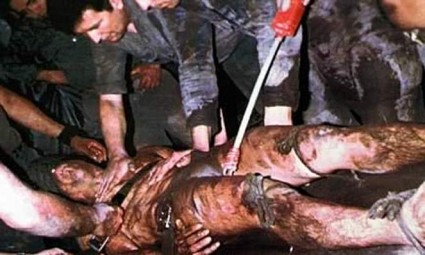Human Resource Exploitation, CIA Wrote the Book, Democratic Oppostion Reaps the Harvest
Psychologists and Torture, Then and Now
By Laura Melendez-Pallitto and Robert Pallitto – 1 March, 2012 – FPIP
History repeats itself, Marx famously warned, first as tragedy and then as farce. In the case of U.S. torture psychologists, the ” tragedy” occurred half a century ago when CIA-funded psychological research on electroshock treatment, sensory deprivation and the like found its way into the Agency’s counterintelligence interrogation manual. The 1963 KUBARK Manual and its later iterations were used widely by U.S. intelligence and disseminated to other governments in Latin America and Southeast Asia.
The “farce” was played post-9/11, as psychologists became involved once again in aiding counterintelligence interrogators. Although some of the material in KUBARK remained in use, psychologists augmented already- existing material with newer techniques, some of which had been developed from torture resistance protocols used to train U.S. military personnel to survive capture and interrogation themselves. Thus, as Katherine Eban has reported, discoveries initially applied to help possible torture victims were later used to break interrogation subjects held in U.S. custody. Psychologists were complicit in designing and using techniques to break subjects rather than aid them, and in so doing they made a mockery of their ethical obligation to “do no harm.”
Twice, then, psychologists forged relationships with the state in which they cast ethics aside. And both times they acted with impunity.
The KUBARK Precedent
The KUBARK Manual cites Albert Biderman and other research psychologists as sources for the “scientific findings” that support its conclusions. Biderman, who died in 2003, was known for his studies of U.S. personnel captured by the Chinese during the Cold War. He examined the ways in which the Chinese military induced false confessions – often outlandish and implausible ones – from U.S. prisoners. Whatever one thinks today of the validity and cogency of that literature, the government used it to legitimize tactics and propositions that go well beyond the claims of the literature itself. KUBARK instructs interrogators to use protocols entitled, “Ivan is a Dope,” “Alice in Wonderland,” and “Mutt-and-Jeff.” Some of these tactics recall the stationhouse “third degree” sessions documented by the 1931 Wickersham Report on police abuse; others appear even more ad hoc and arbitrary. To some extent, the bibliographical citations to social psychology literature provide window-dressing for a how-to on coercive interrogation practices. They help to create a scientific-sounding discourse of counterintelligence interrogation.
KUBARK does not describe in detail the ways in which psychological interrogation methods (“clean torture,” as Darius Rejali calls it) are done. KUBARK merely recognizes that “chemical and electrical” methods are available (though it may be more specific in the redacted portions). To see how sensory deprivation and electroshock treatment actually work on the psyche of subjects, we must look outside KUBARK itself, at the research findings of scientists and the accounts of victims themselves. Naomi Klein interviewed one such victim who unwittingly became a research subject for Dr. Ewen Cameron of McGill University (a psychiatrist) while Cameron was treating her as a psychiatric inpatient. Cameron administered drug and electroshock therapy on his patient that left permanent, devastating injury. Many years later, she discovered the cause of her injuries when she learned of a legal settlement by the CIA paying unwitting experimental subjects for the damages they suffered. By then, she had become completely disabled as a result of her “treatment.” …more































Add facebook comments
Kick things off by filling out the form below.
Leave a Comment